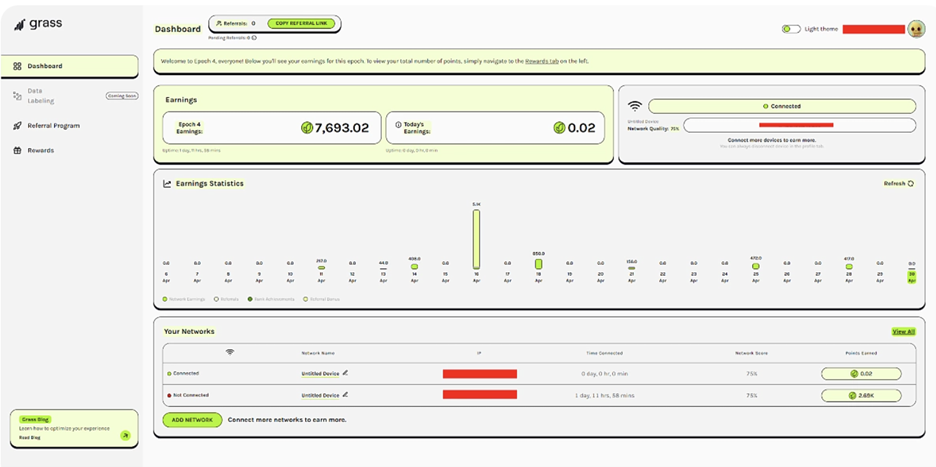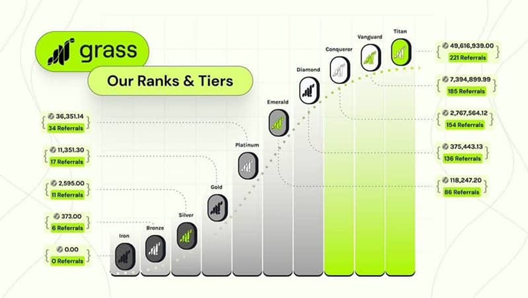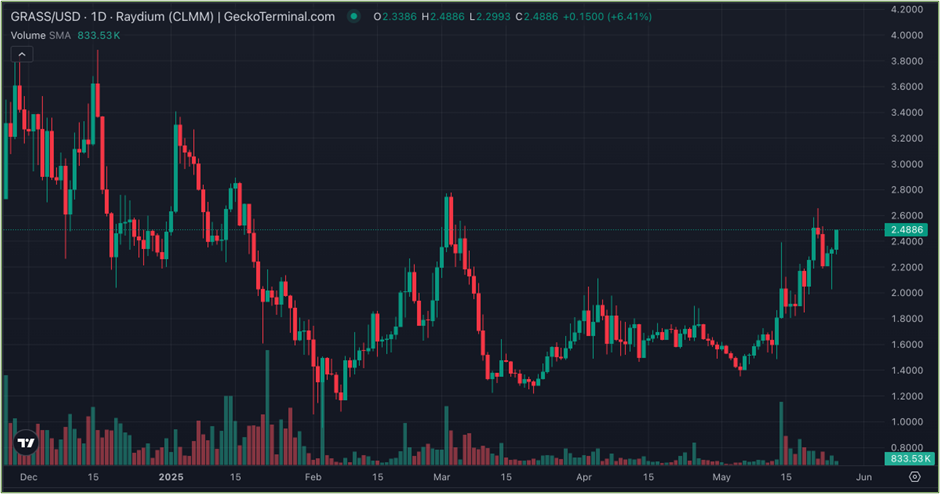Earn Income with Crypto’s ‘Airbnb’ for Idle Bandwidth
 |
| By Bob Czeschin |
Airbnb fundamentally disrupted the hotel industry through decentralization.
It allows landlords and homeowners to turn spare bedrooms into extra cash by renting them to travelers looking for short-term accommodation.
Something similar is happening on the blockchain. And it has created an AI juggernaut that gives users multiple ways to earn.
Decentralizing AI Access
It may seem silly. But your idle bandwidth is a hot commodity. Especially with the rise of AI.
Large language models (LLMS) — like OpenAI’s ChatGPT and Google’s Gemini — require vast amounts of data from public domains on the internet for training.
Accumulating that much data is troublesome and expensive. And TradFi tech giants drop even more money on storage and maintenance of their computers.
That’s why, until now, only large tech firms have been able to roll out the impressive AI models we use in our day-to-day lives.
But Grass (GRASS, “B”) plans to disrupt this process.
Like Airbnb did in the travel industry, GRASS is decentralizing AI data aggregation and access.
And in so doing, it has made space for average users like you to benefit.
How It Works
Anyone can be a data supplier to the Grass network.
All you have to do is register and download the app. And in no time, you’ll be getting paid Grass Points, redeemable for GRASS tokens.
Grass then aggregates the data from all suppliers and sells to the hungriest data consumers on the planet today — which are trainers of large language AI models.
In short, you get paid for offering internet bandwidth you weren’t even using. And your rewards are based on real economic activity, not speculative trading.

The safety-conscious among you may be put off by the idea of allowing a third party to access your bandwidth.
But that is likely something you already allow all the time.
Think about when your download slows to a crawl because of all the ads embedded in the content?
Those advertisers all appropriate your bandwidth to deliver their pitch. Without permission. Or compensation.
In true web3 and crypto fashion, Grass changes that.
It asks you up front for access to your bandwidth. It pays you for the resources used.
Benefits All Around
Compensation isn’t the only benefit to users.
Grass is designed with privacy and security in mind. As such, it takes bandwidth without collecting your user data to monetize or disclose to outsiders.
Finally, Grass won’t slow your internet connection. The app is engineered to always take a backseat to whatever you’re doing.
And it goes to sleep entirely if your connection is already fully engaged.
But that’s just half of the equation. Grass’s approach to data mining has major advantages over the standard approach giant tech companies have relied on.
Such as:
- Recency. Because GRASS does live data mining, the very latest data is always harvested.
- Decentralization. Because GRASS is decentralized, its data is geographically unbiased.
- And because it operates through thousands of IP identities (corresponding to its bandwidth contributors), it can’t be rate-limited by data sources.
- Solid data provenance. An LLM is only as smart as the data it was trained on. Bad or selectively chosen data could skew an AI’s performance.
- This is a serious problem for AI. Because most of the time, there’s no way to know where training data comes from. Or who might have fiddled with it along the way.
- GRASS is among the first to use data roll-ups, zero-knowledge proofs and other advanced crypto tech to establish and verify the provenance of all the training data it harvests.
Advantages like these in a red-hot sector like AI makes this potentially a great business.
And, thanks to the decentralized nature of Grass — and the low operating costs — it can offer access to its datasets for much less than tech firms do.
That doesn’t just democratize AI access so smaller firms can join the revolution.
It could just turn the current industry leaders into future Grass customers.
How Much You Can Make
There are a few factors that can impact how much Grass will pay for your bandwidth.
First is internet speed. The faster your connection, the more you can earn.
Second is the number of devices. The more you’ve got simultaneously connected, and the longer they run, the more you can earn.
Third is location. Web domains with data useful for training are disproportionately in U.S., U.K. and the EU.
Proximity makes users in these areas more valuable, increasing their earning potential.
Finally, Grass also pays you for referring new users.

Right now, average users worldwide likely earn about $50 a month.
Users in the U.S. or Europe with a high-speed connection and multiple devices connected 24/7 could potentially earn up to $100 a month.
But GRASS is just getting started.
Business is presently only a tiny fraction of what it could become. AI is growing explosively. And as market demand for training data surges, so will user earnings.
To learn more or give the GRASS app a try, click here.
2 More Ways to Earn
Contributing bandwidth isn’t the only way to earn with Grass.
You can also buy the token and go for traditional capital gains.
After bouncing around between $1.35 and $2.00 since March, GRASS recently broke decisively above $2.
Going forward, it could re-test its all-time closing highs near $3.60.

That alone is a 55% increase before it makes a new all-time high!
Though you should always keep in mind that crypto is famous for its volatility. So, never invest any money you cannot safely afford to lose.
The final opportunity to earn comes once you have GRASS tokens — either through swapping or as rewards for your bandwidth.
And that’s via staking.

The yield at the time of writing is 35.8% APR.
This will vary according to market conditions. And since yield is shown as “APR,” that means it is not compounded.
In crypto, yields can compound as frequently as every five seconds.
So the true compounded yield — Annual Percentage Yield (APY) — you could target may actually be quite a bit higher than the APR.
By staking, you can add a solid stream of passive crypto income to your total return on GRASS.
One note is that staking GRASS requires a 7-day unlock period.
That means, if you want to withdraw your capital, you’ll need to wait seven days before those tokens are back in your wallet.
In crypto, seven days can be an eternity. GRASS could more than double in a week. Or it could correct by 50%.
To limit this risk, it would be wise not to stake not more than about 20% of your total GRASS holdings at any one time.
Even if staking isn’t for you, I strongly suggest you give Grass more than a cursory glance.
This AI juggernaut is set to revolutionize AI building and access. And it gives you multiple ways to benefit along the way.
Best,
Bob Czeschin

